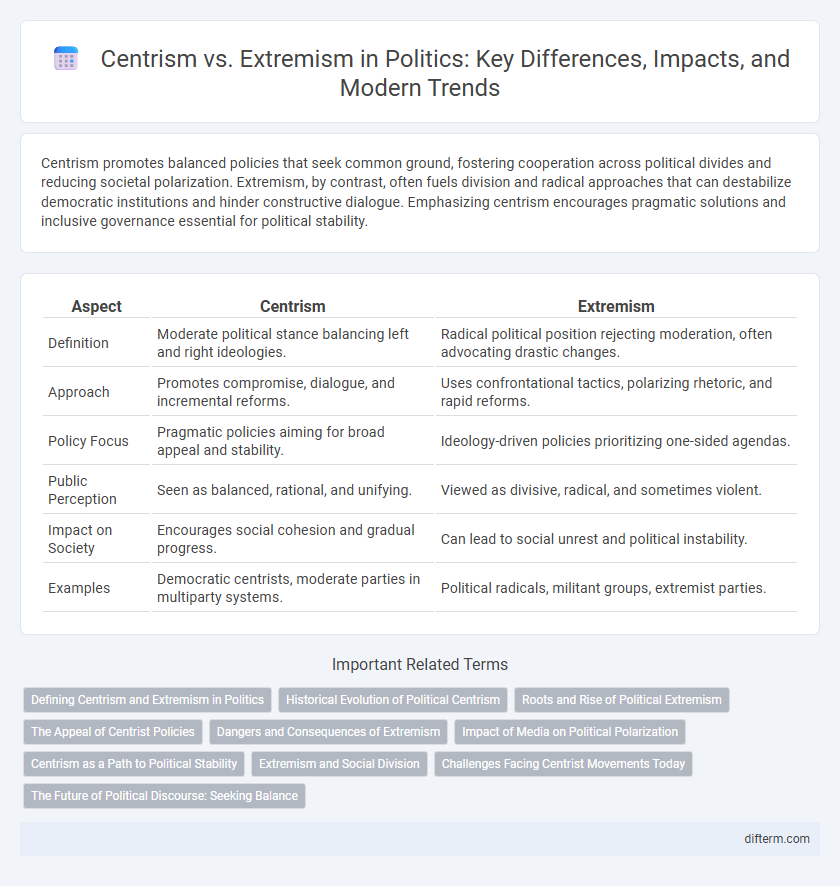Centrism promotes balanced policies that seek common ground, fostering cooperation across political divides and reducing societal polarization. Extremism, by contrast, often fuels division and radical approaches that can destabilize democratic institutions and hinder constructive dialogue. Emphasizing centrism encourages pragmatic solutions and inclusive governance essential for political stability.
Table of Comparison
| Aspect | Centrism | Extremism |
|---|---|---|
| Definition | Moderate political stance balancing left and right ideologies. | Radical political position rejecting moderation, often advocating drastic changes. |
| Approach | Promotes compromise, dialogue, and incremental reforms. | Uses confrontational tactics, polarizing rhetoric, and rapid reforms. |
| Policy Focus | Pragmatic policies aiming for broad appeal and stability. | Ideology-driven policies prioritizing one-sided agendas. |
| Public Perception | Seen as balanced, rational, and unifying. | Viewed as divisive, radical, and sometimes violent. |
| Impact on Society | Encourages social cohesion and gradual progress. | Can lead to social unrest and political instability. |
| Examples | Democratic centrists, moderate parties in multiparty systems. | Political radicals, militant groups, extremist parties. |
Defining Centrism and Extremism in Politics
Centrism in politics advocates for balanced policies that incorporate moderate views from both the left and right, aiming to promote social cohesion and pragmatic governance. Extremism, in contrast, involves radical ideologies that reject compromise and often support aggressive or uncompromising measures to achieve political goals. Understanding these distinctions is crucial for analyzing party platforms and voter behavior in contemporary democratic systems.
Historical Evolution of Political Centrism
Political centrism evolved from 18th-century Enlightenment ideals seeking rational compromise between monarchy and radical democracy. The 19th century witnessed centrism's rise amid growing class conflicts, advocating moderate reform over revolutionary upheaval. Post-World War II, centrist parties gained prominence by promoting social welfare and market economies, countering the extremes of fascism and communism.
Roots and Rise of Political Extremism
Political extremism often stems from deep-rooted social, economic, and cultural grievances that drive individuals toward radical ideologies promising swift and transformative change. The rise of extremist movements correlates with periods of political instability, economic disparity, and perceived failures of centrist policies to address urgent societal needs. Understanding these roots highlights the importance of resilient democratic institutions and inclusive political dialogue in countering polarization and fostering stable governance.
The Appeal of Centrist Policies
Centrist policies attract voters by promoting pragmatic solutions that blend elements from both left and right ideologies, aiming for balanced governance and social cohesion. This approach emphasizes moderation, economic stability, and incremental reform, appealing to individuals wary of political polarization and radical changes. Centrist governance often fosters bipartisan cooperation, which can lead to more sustainable and widely accepted policy outcomes.
Dangers and Consequences of Extremism
Extremism in politics threatens democratic stability by fostering polarization, undermining dialogue, and inciting social unrest. Radical ideologies often facilitate the erosion of civil liberties and the rise of authoritarianism, leading to violence and human rights violations. The pervasive impact of extremism disrupts societal cohesion and hampers effective governance, contrasting sharply with the inclusive approaches of centrism.
Impact of Media on Political Polarization
Media fragmentation amplifies political polarization by creating echo chambers where centrism struggles to gain traction against extremist narratives. Social media algorithms prioritize sensationalist and emotionally charged content, intensifying divisions and reducing opportunities for balanced discourse. This environment hinders compromise, making political moderation less visible and less influential in public debate.
Centrism as a Path to Political Stability
Centrism fosters political stability by promoting balanced policies that integrate diverse perspectives and mitigate polarization. By focusing on pragmatic solutions rather than ideological extremes, centrist approaches enhance social cohesion and reduce conflict potential within democratic institutions. Empirical studies reveal that countries with strong centrist coalitions often experience lower political volatility and sustained governance effectiveness.
Extremism and Social Division
Extremism intensifies social division by promoting polarized ideologies that undermine political stability and community cohesion. Radical viewpoints often marginalize moderate voices and foster an environment of distrust and hostility among diverse groups. This fragmentation disrupts democratic processes and impedes effective governance.
Challenges Facing Centrist Movements Today
Centrist movements today face significant challenges including political polarization that marginalizes moderate voices and the growing influence of extremist factions exploiting social media algorithms to amplify divisive rhetoric. The erosion of trust in traditional institutions further complicates efforts to build broad coalitions necessary for centrist policies, while economic inequality and cultural anxieties fuel populist appeals on both ends of the spectrum. Effective centrism requires innovative strategies to engage disillusioned voters, promote nuanced dialogue, and counteract the simplistic narratives perpetuated by extremist groups.
The Future of Political Discourse: Seeking Balance
Centrist politics advocate for pragmatic solutions and inclusive dialogue, aiming to bridge polarized viewpoints and foster social cohesion. Extremism, by contrast, often amplifies division and ideological rigidity, undermining democratic institutions and constructive debate. The future of political discourse hinges on embracing moderation while addressing urgent societal challenges through evidence-based policies and respectful engagement across the spectrum.
centrism vs extremism Infographic

 difterm.com
difterm.com